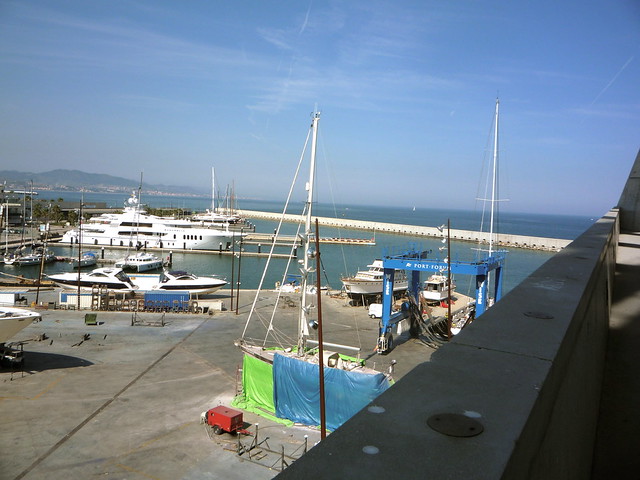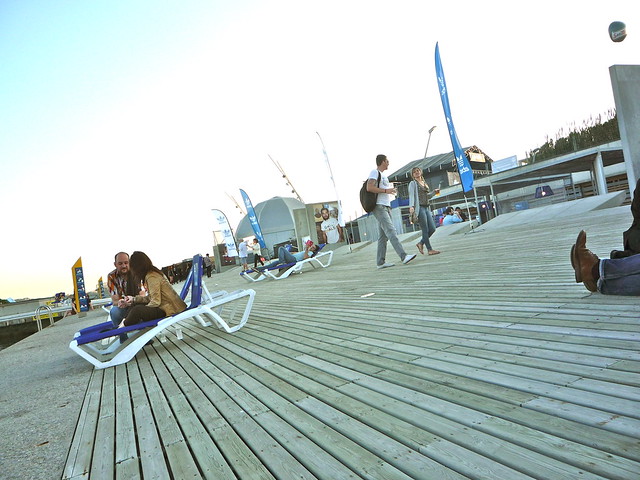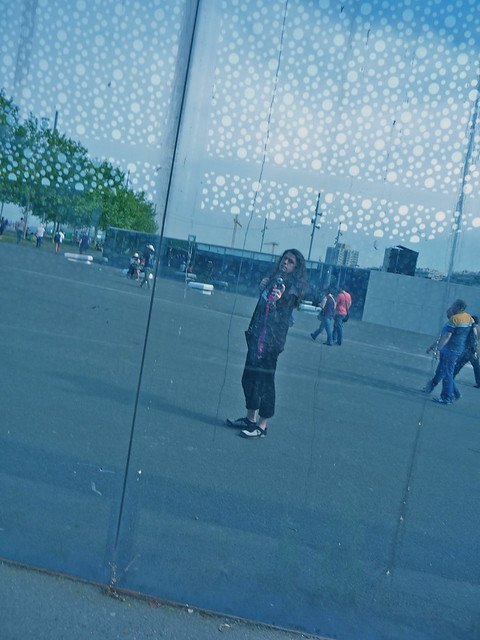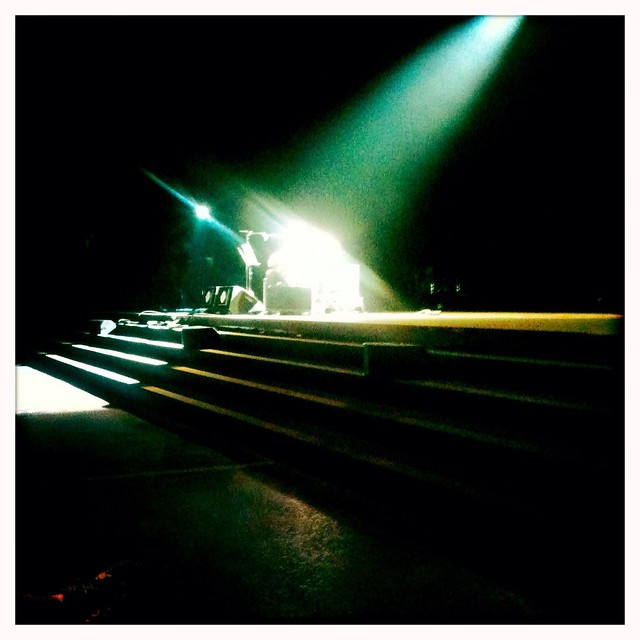Hitchikers 2012-06-22
Octopus hitches lift on Dolphin's genitals : I once had an octopus attached to my forearm for ten minutes. Harder to shift than melted chewing-gum.
Octopus hitches lift on Dolphin's genitals : I once had an octopus attached to my forearm for ten minutes. Harder to shift than melted chewing-gum.
If it's the last weekend in May, then it must be time for me to go to Primavera Sound ! Barcelona's premier eclectic music festival, or as I like to call it, only semi-jokingly, my annual trip to Spain to watch Shellac. It seems like I've been going forever now, but when I tally up, I think this year is only my sixth visit. Enough for the memories to blur together somewhat; I'm starting to find navigating around the site confusing; each year there is a gradual migration of stage locations, and a subtle shuffling of stage names.

You can buy early-bird VIP passes shortly after they confirm the dates for the festival, which is far in advance of any lineup announcement. These sell for around the same price as the eventual full festival pass, but confer various privileges to reward the faithful. This year, I was finally smart and planned ahead. and I got us a pair back in July. Ah, hubris. Subsequently we fell pregnant, and had a baby just four weeks before the festival, making a mockery of my forward planning, and invalidating our usual routine of attending as part of an extended family holiday. I ended up scaling my visit right back down to a quick in-and-out just across the festival days, and after a couple of potential takers for my second ticket fell through, I ended up attending on my own.

It turns out Barcelona is still pretty much my favourite place on earth. In a break from the usual routine, I was staying in a hotel out close to the festival site, at the far end of the Avinguda Diagonal , rather than an apartment somewhere more central. The facilities nearby are pretty excellent, if a little characterless, with the large modern Mall development el Diagonal Mar providing pretty much every consumer amenity you might need, including free Wi-Fi. It's still easy to reach central Barcelona on transit during the sociable hours of day, and it solves the problems associated with picking a time to leave the Festival, and locating a means of transport home, once you hit the small hours of the morning on the weekdays. Door to door from the festival to my hotel was a leisurely ten minute walk.

Once again I had a really good time. I had a few reservations heading in. Last year was a bit crowded, and occasionally hard work. Being on my own was is a bit weird. I've done stints working away from home, but they aren't like this. Luckily I did find some people to talk to at Festival; I enjoyed the chance to spend some time with Matt and Anne , and I also bumped into a few friendly groups by chance; Mike and the Canadian islanders, and those nice chaps from Leicester from the Jeff Mangum queue. Hello to any of you who find your way to reading this!
The upside of attending on my own, it meant I was able to watch lots of bands. I overdid things a little on the Thusday, watching upwards of twenty acts in a session stretching from 4pm through to 4am. I subsequently found myself flagging a little through the middle of the session on the Friday, and finally found a happy balance for Saturday. Weather was excellent, probably the hottest Primavera I've attended. I even managed a mild sunburning on the elbows on Thursday, and I rarely sunburn. The VIP passes turned out to be a good bet - subsidised bars, segregated rest and food areas, and easy access to the indoor concert hall for the posh gigs.

Shellac completely owned it, once again. Year after year, always different, always the same. My other musical highlights were Kleenex Girl Wonder, Spiritualized pulling "Electric Mainline" out of the back catalogue in the middle of a perfect festival setlist, the pro-celebrity karaoke festival of the Big Star's 3rd tribute ( Mike Mills! Norman Blake! Ira and Georgia! Alexis from Hot Chip! ), and I need to pass out a special mention for the marathon Cure set. A bedrock foundation act from my indie disco days, they played a 30-odd song set of old fanservice and hit singles, and I nodded along from the VIP lounge, surprised by how much of it I recognised, given that I own precisely one Cure LP ( Disintegration , naturally ), and one single ( Inbetween Days, I'm predictable like that)
Here's everything I saw, replete with aribitrary ratings :
Baxter Dury ★★ Afghan Whigs ★★ Wilco ★★ Franz Ferdinand ★★ Death Cab For Cutie ★ The xx ★★ Spiritualized ★★ La Estrella De David ★★ Pegasvs ★★ Iceage ★ Grimes ★★ Danny Brown ★ A$AP Rocky ★★ Peter Wolf Crier ★★ Field Music ★★★ Kleenex Girl Wonder ★★★ Dominant Legs ★★ Bombino ★★ Lovely Bad Things ★★ Other Lives ★★ The Cure ★★ Afrocubism ★★ I break horses ★★ Dirty Beaches ★ Sleigh Bells ★★★ Nick Garrie (plays "The Nightmare of J.B. Stanistlas") ★★ Jeff Mangum ★★ Big Star's Third ★★★ Picore ★ Orthodox ★★ Sharon Van Etten ★ Justice (live) ★★★ Beach House ★★ Neon Indian ★ Demdike Stare ★★★ Shellac ★★★ The Pop Group ★ Atlas Sound ★★ Michael Gira ★★ Milagres ★★ Jenn Grant ★★ Cadence Weapon ★★
There weren't too many low-lights. Occasional bar queues. The subsidy at the VIP bars meant that the occasional drink bought outside of those enclosures had a costly sting. A couple of occasions of queuing; to collect the passes, and to get a ticket for, and then gain access to the limited entry Jeff Mangum show. Aggravating cancellations , Björk, Death Grips, Sleep and Melvins - acts I wanted to see, and in the case of Sleep, probably my ideal of the biggest single draw of the festival. Luckily I'm a veteran, pragmatic festival-goer, I don't place too much weight on being able to see individual acts. If I hadn't already seen Sleep at ATP vs Fans:2, I might perhaps think differently.
Leading up to the festival I had been wondering if it was going to be my last year at Primavera. Logistically it's growing more awkward to arrange, I've been a serial attendee for years, and sooner or later the charm should wear off. The inaugural edition of the Portugese sister festival had been catching my eye, And then everything worked it's usual magic. I plan to head back to Barcelona for 2013 if I can. Maybe I'll see you there.
Restore Bounce Mail : Mail.app lost it's "Bounce Message" command in Lion. Restore it via AppleScript.
1950s Huffy Radiobike : All I want for Christmas. Even though I can't ride a bike. Note the tube amp.
Alternative "Heroes" : Reject cover shots, by Masayoshi Sukita, via retronaut .
Whales can adjust their hearing : Russian scientists present evidence that some whales can dynamically recalibrate the responsive range of their sense of hearing.
Compelling case for road pricing : According to a new report by the institute for fiscal studies, the UK requires a radical overhaul of road taxing to sustain revenues.
How to make XCode's UI work for you (maybe) : Wait a minute… XCode 4 has tabs?
 As of 4:29 this morning we have a second daughter! Emergency C-section delivery, but both mother and daughter are stable and doing well. Father inordinately proud. We are thinking of calling her Grace.
As of 4:29 this morning we have a second daughter! Emergency C-section delivery, but both mother and daughter are stable and doing well. Father inordinately proud. We are thinking of calling her Grace.
elfm.el is a rudimentary last.fm radio client implemented within emacs lisp. I wrote this at work to present at our internal "Radio Hackday"; dedicated to encouraging staff to experiment with the radio services and API , and make something with them in a day and a half for show-and-tell. Kind of 20% time distilled right down to an essence.
I wasn't sure if I was going to have enough time to contribute anything, so I wanted to focus on something I could hack on by myself, because I didn't want to hold a team back if I got called away. So I picked something jokey, inessential, yet hopefully thought-provoking, as per my usual idiom.
I had a real blast participating. I don't usually get time to attend things like proper hack days, being all old and family-bound. I really enjoyed the atmosphere of inspiration and industry. All the other hacks were amazing, and waiting for my turn to demo I felt quite embarrassed about my stupid cryptic toy, but it worked perfectly in the spotlight. I got almost all the laughs, and all of the bemusement I was aiming for.
The code is here . It is awful. I haven't written any coherent lisp on this scale for many years. It uses too many global variables and special buffers. It doesn't scrobble. I had to rewrite all my planned asychronous network event machine halfway through implementation, when I re-discovered the lack of lexical closures in elisp. ( I've been reading too many common lisp books in the interim, I suspect ). I think there's enough of the germ of a useful idea in there that I might just clean it up and try and extend it into a proper thing.
I built and run it using GNU Emacs 23.4.1 . I used an external library for HTTP POST , which I found on emacswiki ( HTTP GET I glued together using the built in URL libraries). I've also put a copy of the version I used in the distribution directory. I used mpg123 for mp3 playback, which I installed using Mac Ports . The path to mpg123 is hardcoded in the lisp somewhere, probably inside play-playlist-mpg123.
Here's my demo script, which I evaluated in a scratch buffer. Evaluating these forms in sequence will authorise the application, tune in the radio, and then fetch a playlist of five tracks and start playing them.
;;;; -----DEMO , this example code is out of date, see README
; will open a browser to authorise application
(authenticate-app)
; authenticate a user session
(start-user-session)
; tune the radio to this URL
(radio-tune "lastfm://user/colins/library/")
; refresh the playlist
(get-request (get-playlist-url))
; filter the playlist response to sexps, play the list
(play-playlist-mpg123 (reduce-playlist))
There is only one playback control at the moment; stop, which you can manage by killing the buffer lastfm-radio which has the playback process attached to it. You can retune the radio with any lastfm:// URL format , by re-evaluating radio-tune, and then refreshing and playing the playlist i.e. repeating the last three steps in sequence.
The internal hackday was a cracking idea. Most of the hacks were focused around radio enhancements with broad-ranging appeal, the vast majority of them looked practically useful. I suspect most of the work will filter out into site and product updates. In addition to this, and perhaps more valuably, it worked really well as a community exercise, evolving knowledge-sharing, cross-team working, and enthusiasm, and converting them into inspiration, craft, and art. More of this sort of thing, everywhere!
I've iterated on the original hack quite a lot to make it slightly less brain-damaged, and a bit cleaner to import into anyone else's emacs. Updated code is here and so is a README file with updated running instructions. It's still not really in a usable state for anyone else, but it's amusing me to fiddle with it, and I vaguely plan to get it to a releasable alpha state, at which point I will publish a repository.
For the last few weeks I've been utterly immersed in a fairly exlusive relationship with David Bowie. He doesn't know anything about it,unless he makes a habit of checking out people's play counts on last.fm . It's just me and his back catalogue. This relationship is mostly played out in trains. On headphones, music fed from iTunes or Spotify. Complete albums at a time, played through in the correct running order, naturally. As I listen my eyes are glued to an electronic book. A book about David Bowie and the same songs I'm almost obsessively listening to.
It began with the book, or perhaps I mean to say it awoke. A few weeks ago, listening to Word Podcast 188 , I heard about Peter Doggett's latest book . Commissioned as a sequel, or at least inspired by Ian MacDonald's influential song by song Beatles chronology: Revolution In The Head . I thought the idea was sound, if any classic rock canon could bear the load of similar scrutiny, it was probably Bowie. I noted the book on my 'to read' list, and the next time I found myself without an ongoing book, whilst waiting to depart St. Pancras International, having recently ended one book, I bought the Kindle edition, via "Whispernet". I do most of my book reading on trains. I thought it would probably make an interesting read, despite knowing that I didn't really enjoy listening to Bowie's music.
It wasn't always that way. At some level I would still identify myself as a Bowie fan; albeit a heavily lapsed one. We go way back together. His commercial peak as a pop star ( Let's Dance ) neatly coincides with the start of my interest in the pop charts. He still seemed a current, voguish music figure. The promo video was a new central focus of pop culture, and Bowie was of course one of the craftiest, most-prepared of the video pioneers.
Access to archive media was rare then, and fashion was forward-looking; any consciously retro styles were focused on the '50s. I remember a classmate at boarding school, with the archetypal 'older brother with record collection' filling me in on the standard mythology. The multiple identities, snatches of song titles and character names and iconography all seemed unimaginable and distant. Fascinated by the scraps, I used my sense of wonder to fill in the gaps.
I remember the first time I saw a photo of Ziggy Stardust , years later. It was in a newspaper colour supplement. There was a stock photo collage piece on 'The Many Faces of David Bowie'; probably already a cliche even then. Like anyone, I was knocked out just by the look of it. It was preposterous; somehow ridiculous and cool. A vision from the future, even 15 years out of date.
Bowie still pops up throughout the rest of the decade. He's still a face. Movie and soundtrack work. Labyrinth . Absolute Beginners . When the Wind Blows . I watch all of these at home on a VCR.
I pretend to study for 'A' levels, at the local sixth form college. A grim time for chart music, the fag end of the Stock Aitken Waterman years, just running up against the first twinklings of rave culture. There's a jukebox, with actual seven inch singles in. Most of them are by Rick Astley, or Sonia, or Michael Bolton. There's a 'Golden Oldies' section with maybe a dozen records over on the far right side. 'Ziggy Stardust' is one of them. I play it once or twice a day for weeks. After this, a little piece of me is always slightly disappointed each time I play an electric guitar and it doesn't sound very much like Ronson .
Tin Machine are next along, the sheer contrariness of this scheme just delights me; although I never get to hear much of the music, there's a near media embargo on it. As I move through the 90s, with a gradually solidfying income, I fill out my CD collection with all the back catalogue. It gets solidly played until I've commited the bulk of it to heart.
I'm amused by the negative attitude to 'Drum and Bass Bowie' from the inkies, most of these still in thrall to the last few coughs of Britpop. I like the singles more than most others from that year.
Then it's spoiled. Glastonbury 2000 kills it. Against my better judgement, I trek down to the pyramid stage to watch Bowie's headline set. Stadium Rock is not my thing. I stand in the mud for a while, and I try to watch on the giant TV screens on the other side of the crowded field. It's too slick, too caberet, I'm completely disengaged and intensely disappointed. I leave them to it after half a dozen songs. Something feels quite broken. After that, I find it hard to listen to the old records in a more than academic way.
Nonetheless, now I'm reading the book, I put a playlist together that covers all the albums it discusses. I'm mostly reading on the train, and this means I'm mostly listening as I read. It's a peculiarly immersive way to listen to records. I tried it once before, with Scott Tennent's book about Slint's Spiderland . I read that on the Northern Line, with the album on rotation. Eventually it almost felt like I'd been present at those recording sessions.
It leaks into your ears, ambiently informing your reading. Occasionally mid-passage about the invention or arrangement of a song co-incides with the track playing everything pulls into focus across multiple senses. Berlin-period Bowie plays particularly well with rail transport, with it's stations and trains and mechanical sounds. Listening to Heroes, waiting platformside in the raw concrete trenches of Stratford International .
The book itself is a solid read. Bowie remains an unsurprisingly opaque presence, and some of the speculative interpretation on lyrics and motivation feels like a stretch. The musical analysis likewise falls falls a little short of the template established by 'Revolution In The Head', occasionally quite gratingly clunky (a 'sustained fourth' chord?). Luckily the framing works just as well. Imposing a narrative upon the chronological order of recordings creates an appreciation of it as one body of work. Considered so forensically, it's an astonishing thing. Much as with the previous book, what stands out just as markedly as the quality of the songs and recordings, is the rate of progress, and the rate of change. Here's a rough calendar of the recording dates of the albums covered within 'The Man Who Sold The World'.
I still find this list astonishing. Just five years separate the psych-folk/music-hall of Hunky Dory and the ambient alienation and hyper-stylised funk of Low. A further four years between that and the proto-industrial-cum-New Romantic Pop of Scary Monsters. It's a lot of terrain to cover in a decade, banging out over an album a year interspersed with global touring. For the sake of convenience, I have left out the live album releases.
A couple of other interesting points leapt out at me after reading. I realised my instinctive dating of 'Scary Monsters' is mistakenly late. ' Ashes to Ashes ' has been so convincingly retconned as a New Romantic cornerstone, I have been unconsciously sticking it in the middle somewhere around '82-'83 amidst Culture Club and Duran and the Spandaus, and 'Come on Eileen'. The actual recording date puts it barely out of the 1970s, which means that dense, sound bricolage of such modern sounds was hand-stitched in the most analogue ways. Tony Visconti deserves even more of my respect.
The second thing I never before realised, was that the 'Art Bowie' period - the less overtly commercial works spanning from 'Station to Station' to 'Scary Monsters' does rather neatly line up with a management dispute. As I understand it, these records were produced under a settlement that meant a significant portion of royalties were due to a now estranged management organisation. Once this lapsed, he abruptly switched to the ultra-commercial, lucrative career arc prefaced by 'Let's Dance'. Which is of course, where we came in.
A final, unexpected triumph. As a side effect of the book and this entombment in the music. The joy came back. In sounding all the material out new depths, informed by fresh context, and with rested ears refreshed, I've rediscovered my original appreciation for this sequence of records. Pity my poor family.
The only fault I can find with this technique of marrying immersive listening with a scholarly reading is that it is intrinsically retrospective, and perhaps simply nostalgic, and reductive. It obviously requires you find an artist or a work that's had enough time to embed itself in it's surrounding culture, and can never be forward looking.
Best album from the set? I change my mind constantly, but think I most often settle upon 'Low'. There isn't a bad one, although I'll never consider 'Pin Ups' to be essential, and I think I might always find 'Lodger' a little underwhelming. Who's next for the treatment? I'm not sure. I notice there's a book about the rise and fall of Spacemen 3 .
Hackers Documentary : Set around the Hackers Conference of 1984. Contains prototype RMS.
Can birds fly into a headwind faster than their own maximum speed ?: An intriguing suggestion. I've long admired the eider duck's specialized adaption to a brutal climate.
The Bitch, the Stud and the Prawn: " It was a film called Crust. It told the story of a pub landlord who finds a giant seven foot mutant shrimp on a beach. The landlord then decides to teach the shrimp to box - and believes this will make his fortune. "
Creating retain cycles by misusing assertions : The documentation does state it, but it's always worth remembering that NSAssert is only for use inside Objective-C methods.
My friend Jim won 15 quid by solving the New Scientist Enigma Puzzle. The really neat thing is he did it 32 years after the fact. Read all about it here , in his own words.
Would anybody with a working BBC like to contribute a real world run time for his BBC BASIC based solution?
Jim runs the Enigmatic Code blog about his hobby of solving New Scientist's Enigma puzzles using short python programs, which anyone can play along with at home.
L'Inconnue de la Seine : The death mask of this unidentified Parisian teenage suicide became a popular early-20th century objet d'art , eventually the model for the face of the standard CPR training mannequin.
Cauliflower Hindenburg : taken from a series of model reconstructions of famous explosions, made from cauliflower.
'Supergiant' crustacean found in deepest ocean : 34cm amphipod discovered in the Kermadec Trench.